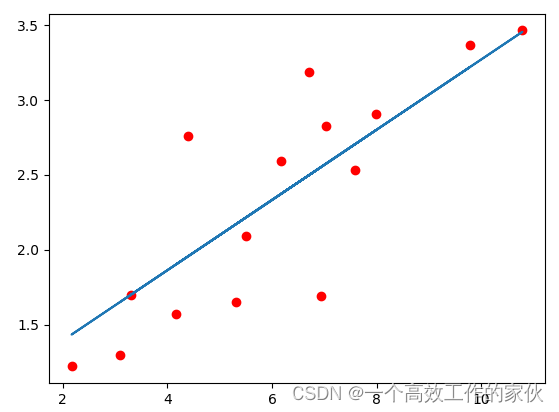热门标签
热门文章
- 1Note: day-4-23-2018 canvas绘制示意灯_java 使用canvas画小灯泡
- 2Linux如何分区_linux home在哪个分区
- 338个常用Python库:数值计算、可视化、机器学习等8大领域都有了
- 4【C++实践】第七章 继承与派生_利用继承性与派生类来管理学生教师档案:由person(人员)
- 5微信小程序苹果iOS长按图片无法转发、发送给朋友、保存,它们无效的解决办法_微信小程序 image 长按没反应
- 6axure如何实现提示框3s后自动消失
- 7云计算——ACA学习 云计算概述_适合学习阿里云云计算aca的书
- 8深入评测:ONLYOFFICE桌面编辑器v8.0——创新特性与协作的新神器_onlyoffice8.0
- 9ChatGPT免费使用网站分享大全,部分可以直接访问_chatgpt3.5免费网站
- 10Android13源码下载及全编译流程_android源码下载
当前位置: article > 正文
PyTorch-线性回归
作者:繁依Fanyi0 | 2024-02-22 04:27:11
赞
踩
PyTorch-线性回归
已经进入大模微调的时代,但是学习pytorch,对后续学习rasa框架有一定帮助吧。
- <!-- 给出一系列的点作为线性回归的数据,使用numpy来存储这些点。 -->
- x_train = np.array([[3.3], [4.4], [5.5], [6.71], [6.93], [4.168],
- [9.779], [6.182], [7.59], [2.167], [7.042],
- [10.791], [5.313], [7.997], [3.1]], dtype=np.float32)
- y_train = np.array([[1.7], [2.76], [2.09], [3.19], [1.694], [1.573],
- [3.366], [2.596], [2.53], [1.221], [2.827],
- [3.465], [1.65], [2.904], [1.3]], dtype=np.float32)
-
- <!-- 转化tensor格式。 -->
- x_train = torch.from_numpy(x_train)
- y_train = torch.from_numpy(y_train)
-
- <!-- 这里的nn.Linear表示的是 y=w*x b,里面的两个参数都是1,表示的是x是1维,y也是1维。当然这里是可以根据你想要的输入输出维度来更改的。 -->
- class linearRegression(nn.Module):
- def __init__(self):
- super(linearRegression, self).__init__()
- self.linear = nn.Linear(1, 1) # input and output is 1 dimension
-
- def forward(self, x):
- out = self.linear(x)
- return out
- model = linearRegression()
-
- <!-- 定义loss和优化函数,这里使用的是最小二乘loss,之后我们做分类问题更多的使用的是cross entropy loss,交叉熵。优化函数使用的是随机梯度下降,注意需要将model的参数model.parameters()传进去让这个函数知道他要优化的参数是那些。 -->
- criterion = nn.MSELoss()
- optimizer = torch.optim.SGD(model.parameters(), lr=1e-4)
-
- <!-- 开始训练 -->
- num_epochs = 1000
- for epoch in range(num_epochs):
- inputs = Variable(x_train)
- target = Variable(y_train)
-
- # forward
- out = model(inputs) # 前向传播
- loss = criterion(out, target) # 计算loss
-
- # backward
- optimizer.zero_grad() # 梯度归零
- loss.backward() # 反向传播
- optimizer.step() # 更新参数
-
- if (epoch 1) % 20 == 0:
- print(f'Epoch[{epoch+1}/{num_epochs}], loss: {loss.item():.6f}')
-
- <!--训练完成之后我们就可以开始测试模型了-->
- model.eval()
- predict = model(Variable(x_train))
- predict = predict.data.numpy()
-
- <!-- 显示图例 -->
- fig = plt.figure(figsize=(10, 5))
- plt.plot(x_train.numpy(), y_train.numpy(), 'ro', label='Original data')
- plt.plot(x_train.numpy(), predict, label='Fitting Line')
-
- plt.legend()
- plt.show()
-
- <!-- 保存模型 -->
- torch.save(model.state_dict(), './linear.pth')
-


声明:本文内容由网友自发贡献,不代表【wpsshop博客】立场,版权归原作者所有,本站不承担相应法律责任。如您发现有侵权的内容,请联系我们。转载请注明出处:https://www.wpsshop.cn/w/繁依Fanyi0/article/detail/128500
推荐阅读
相关标签



